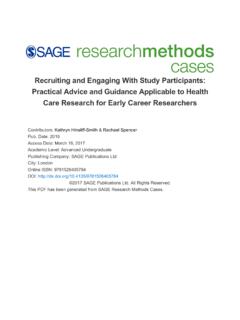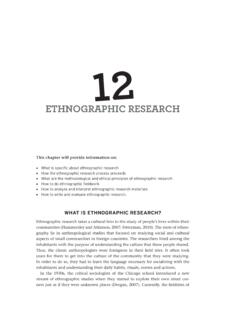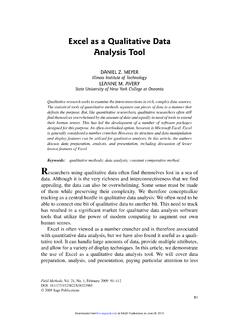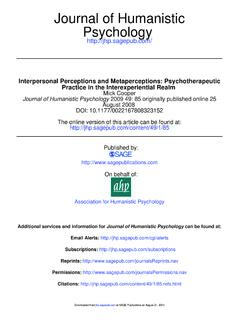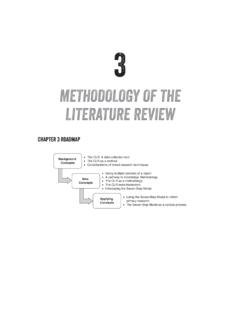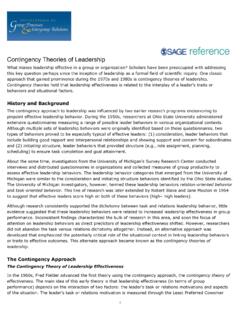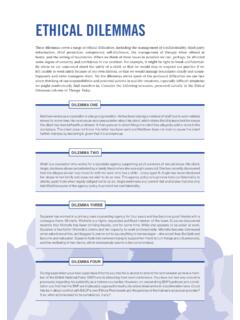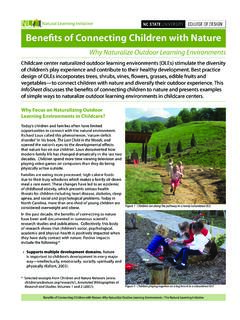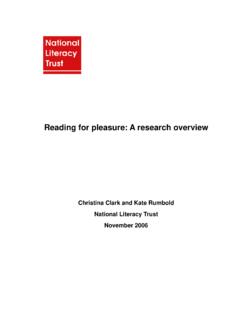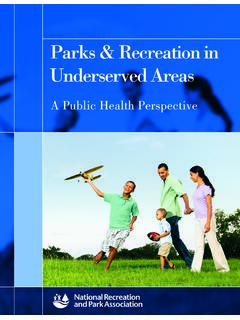Transcription of TEACHING SCIENCE OUTSIDE THE CLASSROOM
1 CHAPTER 2 Chapter aimsBy the end of this chapter, you should be able to: Introduce some of the motivations for promoting SCIENCE outdoors Consider some of the evidence of the benefits of studying SCIENCE out-side the CLASSROOM Suggest ways of using creative TEACHING methods to promote effective scientific enquiryINTRODUCTIONWe couldn t be inspired with a love of the natural world, we couldn t grow up as fully rounded young people unless we spent time out of doors. Not just an occasional trip tacked on at the end of the summer but integrated properly into every subject that we were learning .. I don t believe that any of us can grow up properly in this country unless we ve had the chance to feel and have communicated to us direct the passion for the natural world that the best teachers can bring.
2 I m so glad that the new national curriculum .. [had] such a firm emphasis of giving children that knowledge, and knowledge they can only really grasp if they are educated out of doors.(Michael Gove, Secretary of State for Education ( January, 2014))CHAPTER 11 TEACHING SCIENCE OUTSIDE THE CLASSROOM11_Cutting and 1269/11/2014 11:02:32 AMTEACHING SCIENCE OUTSIDE THE CLASSROOM 127 For those interested in the promotion and implementation of outdoor learning, such comments from the Secretary of State for Education can certainly be seen as a positive affirmation. In the 2014 National Curriculum (DfE 2013) the firm empha-sis that is referred to only really begins to appear beyond primary Key Stages 1 and 2 for until then the only direct references made to outdoor education are in relation to the physical education programme.
3 However, at this point it is worth remembering that the slimmed down 2014 National Curriculum is now seen as the guideline for essential knowledge rather than its more prescriptive precursor. This provides a significant opportunity for teachers and for schools to develop their own approaches and methods for delivering the statutory outcomes in what the National Association for Environmental Education has called one of the greatest opportunities for truly inspirational education .. Learning OUTSIDE the CLASSROOM provides a dazzling opportunity to help contextualize the new National Curriculum at both primary and secondary levels, wrapping real world meaning around dreary lists, and making learning more memorable and inspirational (NAEE, 2012).If you have been in TEACHING for some time you may find the term opportunity something of a well worn euphemism for more work.
4 Taking children OUTSIDE can sometimes undoubtedly be troublesome, occasionally even the simple logis-tics of moving a group of children can prove problematic. This combined with the varied issues (time, cost, risk assessment) that tend to rise up before, during and after trips can sometimes be seen as simply too much , the first question must therefore be, why bother?Time for reflection through the following:In September 2012, a global meeting of conservation leaders worldwide adopted a resolution recognizing the importance of the Child s Right to Connect with Nature and to a Healthy Environment . The International Union for Conservation of Nature (IUCN) resolution called for this to be included within the framework of the United Nations Convention on the Rights of the June 2011, the Coalition Government published the Natural Choice, a White Paper that included the recommendation to strengthen the connections between people and nature (Defra, 2011, p.)
5 44).In 2012 the Natural Environment White Paper (4th Report) stated that Defra set a firm target for increasing public engagement with nature, such as the per-centage of children of primary school age regularly engaging in nature activities . children spend so little time outdoors that they are unfamiliar with some of our commonest wild creatures. According to a National Trust survey, one in three could not identify a magpie; half could not tell the difference between a bee and a wasp; yet nine out of ten could recognize a Dalek. (Moss, 2012)Learning OUTSIDE is a proposed right of the child. The government has genuine concerns about connecting people and nature as do on your own motivation for using, or not using the and 1279/11/2014 11:02:33 AM128 CREATIVE TEACHING IN PRIMARY SCIENCEGOING OUT TO THE INDOORSB efore going further, it is important to point out how there are different meanings to learning OUTSIDE the CLASSROOM .
6 School trips are still common, although increas-ingly perhaps subject to financial pressure. Such trips out, commonly to zoos, aquaria, museums or SCIENCE centres, are significant events. They also provide important and varied learning experiences for the children . Careful planning in relation to timings relative to the curriculum and working closely with the receiv-ing institutions may enhance these visits significantly. Often such institutions have education teams, pre-prepared resources and planned activities that can be both generic or bespoke. They are undoubtedly valuable and worthwhile, however, outdoor learning is just that. It may involve as much planning and resource devel-opment, but provides a very different set of learning opportunities and therefore requires a different set of learning OUTDOOR SCIENCE LEARNING TODAY?
7 Broader considerationsIdeas relating to the importance of children learning OUTSIDE are not new and have a provenance that includes writers such as Rousseau, Montessori and Kolb among many others. However, in the contemporary context there is a growing concern as today children , in the UK at least, now appear to spend significantly less time outdoors OUTSIDE school hours than previous generations and as a result, their direct experience of their environment and the wide benefits that such con-tact seemingly provides is much is probably a truism to say that our childhood world was very different from the one our parents knew as children . Every generation seems to know a singu-lar childhood world and on that basis change seems natural, as it is inevitable. However, perhaps it is the pace of change, particularly in technology, that seems disconcerting.
8 The digital recreational choices children have available to them are as legion as they are seemingly enjoyably addictive. For those of us interested in SCIENCE and technology of course, we can admire the astonishing technologies that have come together to produce these machines and the impressively rapid improvement in graphics and sound quality that are their hallmark. As teachers however, we may be a little uneasy about the attraction of home entertainment. Certainly, over the last few years statistics have begun to emerge relating to children s play patterns. For those who promote outdoor play (and learning) they make poor reading. Sigman (2012) estimated that in the UK by the age of 10 the average child has access to five screens; that children in the UK spend more time in front of screens than they do at school and this in turn has led to growing concern, not only about the changing nature of play, impact on sleep patterns, exercise and attention span, but that children are simply not going OUTSIDE and 1289/11/2014 11:02:33 AMTEACHING SCIENCE OUTSIDE THE CLASSROOM 129 For some time this trend has been identified as also relating to the dissatisfaction with, or simple lack of, appropriate outdoor play areas (Valentine and McKendrick 1997) and from increasing parental concern over children being potentially at risk if they are OUTSIDE alone and unsupervised.
9 No matter how much reassurance one can offer in terms of the very low risk, parents are increasingly reticent to let their children play author Tim Gill likens the loss of children playing unsupervised in parks and green spaces to a human equivalent of Rachel Carson s Silent Spring. The loss of young children from public spaces is like the loss of songbirds. The future is even more worrying for as Sigman (2012) points out, children today, by the time they reach the age of 80 years, will have spent years, nearly a quarter of their lives, in front of suggested general advantages of outdoor learning to children are over-whelming and as such are perhaps too numerous to consider in detail when the focus of this is on using the outdoors for learning SCIENCE specifically. However, in brief, the learning advantages that outdoor settings provide for primary aged children are well reviewed by Waite (2011) and the broad benefits for physical health and social development are detailed in Every Child Outdoors (RSPB, 2010).
10 The benefits of the outdoors in relation to behaviour and mental well-being are also extensively reviewed by Bird (2007) and Bowler et al. (2010).Even a cursory glance through the published literature shows broad and some-times unqualified agreement, that outdoor learning is a good thing. Indeed, even the Office of Standards in Education (Ofsted) in 2008 published a report that found overwhelming evidence that outdoor learning not only contributes signifi-cantly to raising standards but also enhances the quality and depth of learning. By 2010 Ofsted wanted to see through the school inspection framework substantial opportunities for children to learn OUTSIDE the CLASSROOM and that learning OUTSIDE provides for an enjoyable and enriching education (Ofsted, 2010).In a rare convergence of agreement, the Secretary of State for Education, Ofsted and health and educational researchers agree on the significant advantages of outdoor learning.
